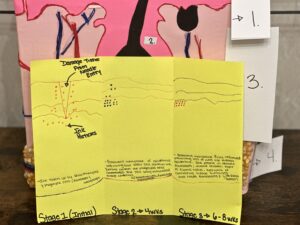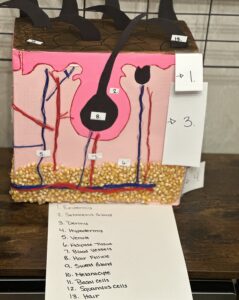The integumentary system is the body’s largest organ. It refers to the skin and its associated structures such as: hair, nails, and glands. The skin provides multiple functions like; protection which provides a barrier against harmful substances, sensation- this allows the nerve ending to detect touch, pressure, pain, and temperature, temperature regulation due to the widen of blood vessels when we sweat, waste elimination through sweat, and the production of Vitamin D which is essential for bone health as well.
The skin covers the entire surface of the body and has three major layers: the epidermis, dermis, and hypodermis. The epidermis is the outermost layer of skin that you can see and feel, it is made of epithelial cells. It is composed of three different cell types: Langerhans, keratinocytes, and melanocytes. This gives the skin its color and acts as a barrier against water. The dermis is the middle layer and thickest made of dense irregular connective tissue, it contains blood vessels, nerves, hair follicles, perspiration, and oil glands. Lastly the hypodermis is the base layer consisting of loose connective and adipose tissue which aid in insulating and cushioning the body.
In this project I will explain the stages of how tattoo ink is dispersed into the skin and the layers of skin it has to go through in order for the tattoo to appear. When a person gets a tattoo the needle goes through the epidermis and into the dermis. A significant amount of the ink that is applied to the dermal layer will be suspended in the collagen matrix, and some of it may even be taken up by the fibrocytes. In the process of tattooing the needle punctures the skin between 50 to 3,000 times per minute. The wound alerts the immune system, promoting the start of the inflammatory process. In an effort to restore the body, specialized cells called macrophages are sent to consume the dye. Despite the fact that many of these macrophage cells remain in the dermis and are visible through the skin, some of them do depart. These fibroblasts and macrophages allow the tattoo to become permanent. When the tattoo is finished, the fibroblasts work to restore and rebuild the tissue. Granulation tissue, which initially appears as soft, pinkish tissue similar to a fresh scar, later develops into fibrous tissue.
Thinking of getting a tattoo? Always keep in mind the risks that are possible:
- Allergic Reaction
- Skin Infection (ex- Staph)
- Burning and Swelling
- Inflamed Tissue
- Keloid (overgrowth)
- Blood Borne Diseases (ex- HIV, Hep. B, Hep. C and Tetanus)
Fun Facts
1. Tattooing was illegal in South Carolina until 2004. Until 2006, it was illegal to get a tattoo in Oklahoma.
2. 23% of people regret their tattoos, with the biggest regret being a tattooed name.
3. Tattoo numbing cream helps with pain; however, it may disturb the inking process on the skin and affect the design’s visual result because it can make the skin swell and deform.
Below you will see a 3-D model of the integumentary system and its labeled parts. You will also see three stages of ink dispersal when the skin has reformed. Thank You!



Cites Sources
- Aguirre, C. (n.d.). What makes tattoos permanent? Claudia Aguirre: What makes tattoos permanent? | TED Talk. Retrieved December 13, 2022, from https://www.ted.com/talks/claudia_aguirre_what_makes_tattoos_permanent?language=en
- Ellis, P. (2021, November 2). A human anatomy lab showed exactly what happens when you get a tattoo. Men’s Health. Retrieved December 13, 2022, from https://www.menshealth.com/health/a36558298/tattoo-skin-what-happens-explained-video-institute-anatomy-lab/
- Gabriel, M. (2022, September 7). 30 astonishing facts about tattoos. The Fact Site. Retrieved December 13, 2022, from https://www.thefactsite.com/tattoo-facts/
